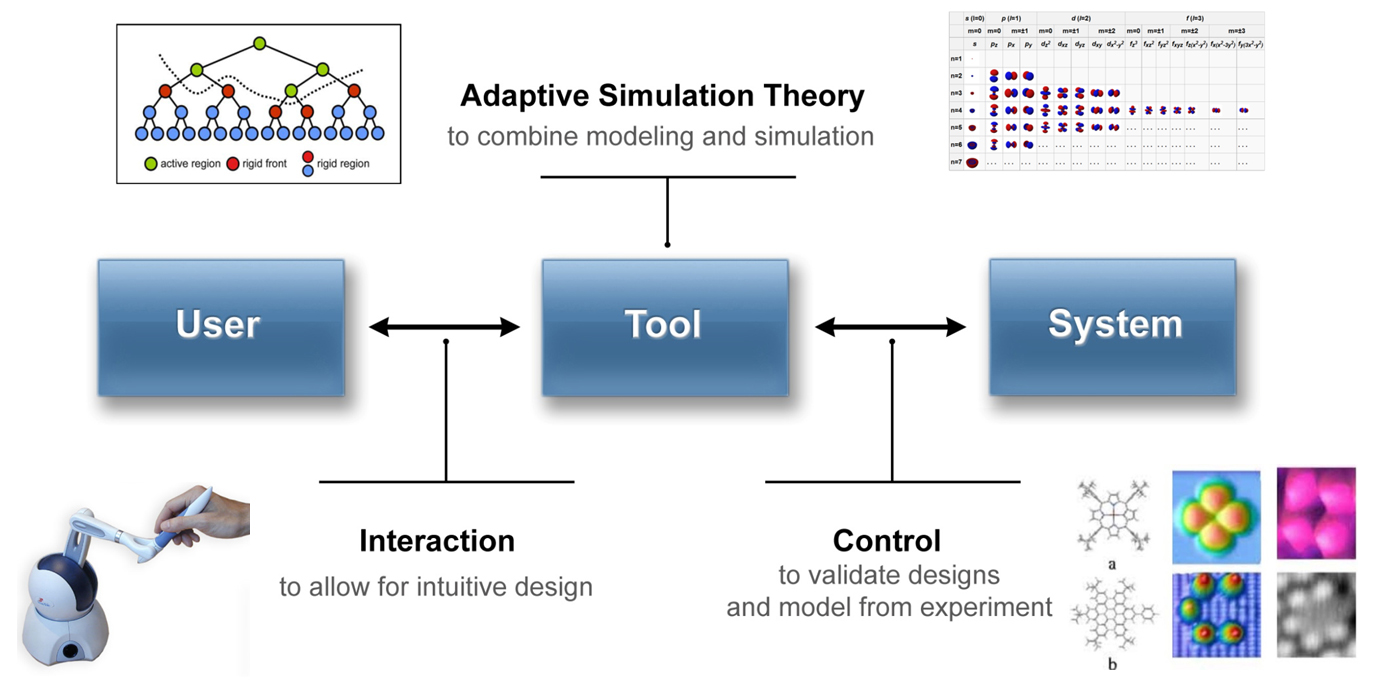Section: Overall Objectives
Research axes
The goal of NANO-D is to help current and future designers of nanosystems by developing some of the mathematical and computational foundations of a software application which will run on a desktop computer, and will allow for efficient analysis, design, modeling and simulation of complex nanosystems, whether they are artificial or natural, or a combination of both. For clarity, the research program of the NANO-D group is best introduced by referring to Figure 1 . There:
-
User is any person who wants to study, analyze, design, model, simulate, and control a nanosystem.
-
Tool is the software application being built on the research performed within NANO-D. This tool will have functionalities that will be similar to those used to design macrosystems (e.g. CATIA, SolidWorks, etc.), but also some others which will be specific to nanoscience.
-
System is the nanosystem being designed, simulated, controlled, etc., and potentially its environment. The environment can be any system in interaction with the given nanosystem: two electrodes between which a nanotube has been placed, the atomic force microscope which interacts with a nano-wheel, a protein interacting mechanically with a nano-drug or an engineered protein, etc.
This simple diagram makes it clear that a complete, coherent effort towards practical design of nanosystems should be organized in three research axes:
-
Adaptive Simulation Theory. This first research axis deals with the core algorithms for modeling and simulation, which constitute the heart of the design functionalities of the tool. The main paradigm in this axis is to rely on divide-and-conquer, hierarchical representations to design to adaptive algorithms for modeling and simulating nanosystems.
-
Interaction. The second group of tasks deals with the interaction of the user with the tool. This is essential, because nanosystems may have complex topologies, kinematics and dynamics, which may make it difficult to edit and model.
-
Control. The last group of tasks deals with the bidirectional relationships between the simulated nanosystems and the actual ones. Indeed, nanosystems may be characterized through a variety of experimental techniques (e.g. Atomic Force Microscopy, etc.). In order to help verify designs, the tool must thus be able to simulate characterization techniques. Conversely, the tool must be able to take advantage of existing knowledge (both experimental and computational) to help the user design nanosystems.
We believe that each of these three groups of tasks is essential. Fast modeling and simulation algorithms allow for relevant, efficient design (“Adaptive Simulation Theory”). However, software tools with powerful functionalities but which are difficult to use (“Adaptive Simulation Theory” without “Interaction”) end up not being used at all. Finally, a tool for modeling and simulating nanosystems which would be “disconnected” from the reality of experimentation (“Adaptive Simulation Theory” without “Control”) could only be used for theoretical designs with little assurance of their practicality.



